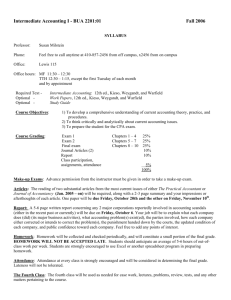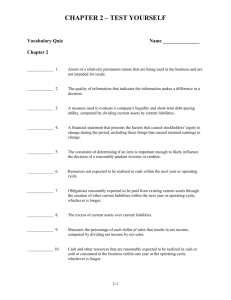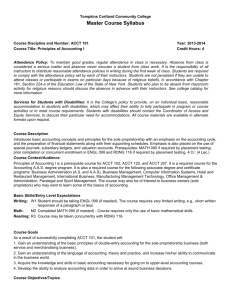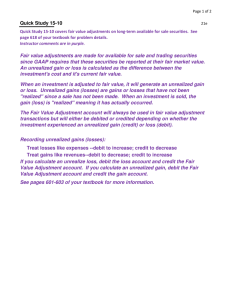Fair Value Measurement: What's New? Teaching Note
advertisement
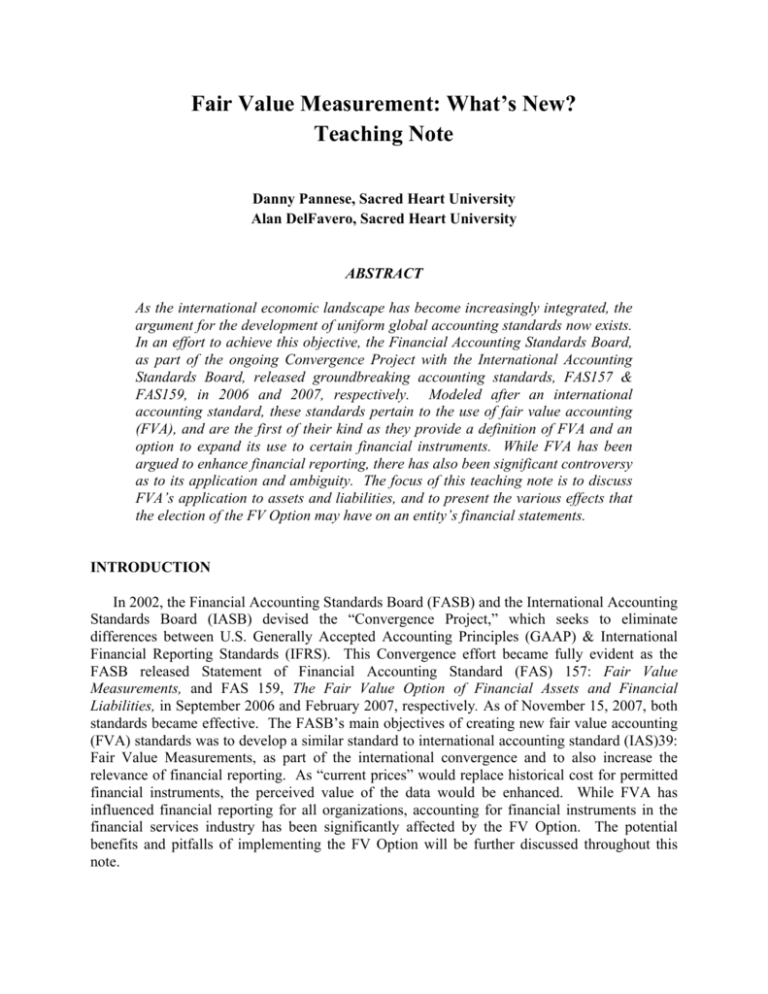
Fair Value Measurement: What’s New? Teaching Note Danny Pannese, Sacred Heart University Alan DelFavero, Sacred Heart University ABSTRACT As the international economic landscape has become increasingly integrated, the argument for the development of uniform global accounting standards now exists. In an effort to achieve this objective, the Financial Accounting Standards Board, as part of the ongoing Convergence Project with the International Accounting Standards Board, released groundbreaking accounting standards, FAS157 & FAS159, in 2006 and 2007, respectively. Modeled after an international accounting standard, these standards pertain to the use of fair value accounting (FVA), and are the first of their kind as they provide a definition of FVA and an option to expand its use to certain financial instruments. While FVA has been argued to enhance financial reporting, there has also been significant controversy as to its application and ambiguity. The focus of this teaching note is to discuss FVA’s application to assets and liabilities, and to present the various effects that the election of the FV Option may have on an entity’s financial statements. INTRODUCTION In 2002, the Financial Accounting Standards Board (FASB) and the International Accounting Standards Board (IASB) devised the “Convergence Project,” which seeks to eliminate differences between U.S. Generally Accepted Accounting Principles (GAAP) & International Financial Reporting Standards (IFRS). This Convergence effort became fully evident as the FASB released Statement of Financial Accounting Standard (FAS) 157: Fair Value Measurements, and FAS 159, The Fair Value Option of Financial Assets and Financial Liabilities, in September 2006 and February 2007, respectively. As of November 15, 2007, both standards became effective. The FASB’s main objectives of creating new fair value accounting (FVA) standards was to develop a similar standard to international accounting standard (IAS)39: Fair Value Measurements, as part of the international convergence and to also increase the relevance of financial reporting. As “current prices” would replace historical cost for permitted financial instruments, the perceived value of the data would be enhanced. While FVA has influenced financial reporting for all organizations, accounting for financial instruments in the financial services industry has been significantly affected by the FV Option. The potential benefits and pitfalls of implementing the FV Option will be further discussed throughout this note. FV ACCOUNTING: A LOOK AT FAS157 & FAS159 FAS157 is considered a landmark accounting standard as it is rendered the first U.S. standard to include a definition of FV and a framework for FV measurement. While FVA has existed for years, previous standards loosely defined FVA and provided guidance that was “limited and inconsistent” as to its application.1 However, the accounting standard does not expand the use of FVA (with the exception of increased disclosure requirements), but presents a measurement framework to “properly” value assets and liabilities already required to be measured at FV by previous accounting standards. Regarding the measurement framework, FAS157 presents a three-tier hierarchy. Level One of the FV hierarchy pertains to the most liquid items. Level One assets and liabilities, such as stocks owned (assets) or bonds (assets or liabilities) are valued using observable inputs, such as a quoted price for identical items in a market with high volume. Level Two applies when a quote for the asset/liability is not readily available, but quotes for similar items are. Items that can fall under this categorization are thinly traded common/preferred stock, inactively traded municipal and corporate bonds, and derivative instruments. 2 Level Three, however, is the most complex and least understood area of valuation. Level Three inputs are the least dependable, since the FVs for these assets or liabilities are based on unobservable inputs. Significant judgment is needed, as mathematical models, valuation specialists, and/or accountant/auditor experience is needed to estimate FV. According to Kieso, Wygandt, and Warfield, authors of Intermediate Accounting, 12th ed., “preparers, users, and auditors will have to understand the valuation methods used to arrive at FV measurements.” 3 It is at the juncture that companies must provide, under the provisions of FAS157, thorough disclosures as to how a FV estimate was derived for these instruments.4 Transparent disclosures are critical. These assets consist of real estate, mortgage-backed-securities, and private equity investments, and collateralized debt obligations. 5 Unlike FAS157, however, FAS159 expands the use of FV measurement. FAS159 gives organizations the option to apply FVA to permitted financial assets or financial liabilities, on an instrument-by-instrument basis. An entity could have applied the FV Option at the initial effective date or to newly purchased/assumed financial assets or financial liabilities. Financial assets are considered to be cash, cash equivalents, receivables, and short/long-term investments, such as stocks, bonds/notes, short-term commercial paper, and investments in derivatives. Conversely, financial liabilities pertain to payables (notes, bonds) and “an obligation to deliver a financial instrument to a second entity.” 6 FAS157 and FAS159 do not apply to assets such as “property, plant, and equipment, inventory, intangibles, and retirement obligations.” 7 Once the FV Option is elected made, it is irrevocable and can be the only basis of accounting used for the chosen financial asset/liability.8 FAS159’s INFLUENCE ON REPORTING OF FINANCIAL INSTRUMENTS Financial securities are classified as either debt or equity in nature and are typically classified as trading, available-for-sale, or held-to maturity securities. Trading securities have always been considered current assets on the balance sheet as they are typically purchased and sold in the short-term.9 Financial assets would be classified as trading securities if management had the intent to only hold the asset for three months or less.10 Realized and unrealized holding gains/losses on these securities were, and will continue to be reported in the income statement as other gains or losses after the FV Option is elected. A realized gain or loss results from the sale of an item. Unrealized gains or losses result from changes in the market value of an item continued to be held by the entity. The FV Option, however, has altered accounting for available-for-sale debt and equity securities. Although available-for-sale instruments (AfSI) were reported at their respective FVs on the balance sheet previously, unrealized gains and losses were recorded in stockholders’ equity as other comprehensive income (OCI), and never included in net income.11 OCI represents all changes in stockholders’ equity, with the exception of contributions by owners and distributions to the owners, during an accounting period. Under the provisions of FAS159, AfSI can be reclassified as trading securities at the initial application date. At this time, the accumulated unrealized gains/losses will be reflected as a “cumulative-effect adjustment to the opening balance of retained earnings.”12 Thus, at the original recognition, unrealized losses would have no effect on the income statement.13 Earnings would be unchanged before and after the reclassification as cumulative unrealized holding gains/losses would increase/decrease only other comprehensive income. Newly acquired AfSI securities, if the FV Option is applied, would always need to be reported at FV. Held-to-maturity securities (HtMS), conversely, are comprised of financial instruments consisting only of debt (notes and bonds) that has been carried on the balance sheet at their acquisition cost “adjusted for the amortization of [a] discount or premium.” 14 In order for a security to qualify as HtM, an entity must be capable of and fully intend to hold a security until its maturity.15 The FV Option allows for these securities to also go through a re-classification as trading securities. At the time of initial recognition, the cumulative unrealized gain/loss will be applied as an adjustment to the beginning retained earnings balance as well.16 However, at this time, the asset “will [also] be reported as a trading security,” but management’s intention to hold the asset until maturity “will not be called into question.” 17 Unrealized holding losses are debited to (decrease) retained earnings, and unrealized holding gains are credited to (increase) retained earnings at the initial recognition. Accordingly, at the initial FV measurement date, there is (was) no net effect on the balance sheet or the income statement. Effectively, after the initial recognition, securities could be sold in the future, and the book loss will not be reported as it has already been absorbed by the opening balance of retained earnings.18 Therefore, net income could be artificially bolstered. Nonetheless, the FV Option can be applied to newly purchased financial assets or financial liabilities incurred by an entity, subsequent to the initial application. All increases and decreases here will flow through to net income. Listed below are two examples focusing on the use of the FV Option with a financial asset and a financial liability. Example 1- FV Applied to a Financial Asset On October 1, 2008, XYZ Bank purchases a $1,000,000, 7% 5-year note, with interest payable annually on September 30 for $935,000. This is XYZ’s only investment and the company chooses to apply the FV Option. This note is categorized as HtM, as management intends to hold this note through its maturity date, October 1, 2013. Without the FV Option, these securities are required to be reported at its amortized cost (face value -/+ bond discount/premium). However, the FV Option allows for all permitted financial assets and financial liabilities to be valued at FV on an “instrument-by-instrument” basis and is irrevocable.19 As of the January 1, 2009 measurement date, the market value of the note declined to $880,000, due to an increase in interest rates for similar, newly issued debt instruments. Presented below is the appropriate journal entry: 1/1/09 Unrealized Holding Loss- Income 55,000 20 Long-Term Note Receivable 55,000 Next, assume that the FV of the note remained stable (ignoring premium/discount amortization) until the September 30, 2009 measurement date. If the FV of these HtM securities (reclassified as trading) rose in value to $925,000, XYZ would post an unrealized holding gain of $45,000 to the income statement. Refer to the journal entry below: 9/30/09 Long-Term Note Receivable 45,000 Unrealized Holding Gain- Income 45,000 Example 2- FV Applied to a Financial Liability The FV Option can also be applied to financial liabilities as well. For example, assume ABC Corp. issues a $500,000 of 6%, 7-year note payable at par on January 1, 2009, and the FV Option is applied. However, deterioration in ABC’s credit worthiness has prompted Moody’s Investor Services to cut the company’s credit rating from Baa3 to Ba2 on September 1, 2009. The market value of ABC’s outstanding notes now decline to $470,000. Presented below is the necessary journal entry to record the gain as of the September 30, 2009 measurement date. 9/30/09 Notes Payable21 Unrealized Holding Gain-Income 30,000 30,000 To be clear, the debt was not extinguished, and therefore, a gain cannot be realized. Further assume that as of the December 31, 2009 measurement date, the company’s credit rating is upgraded to Ba1, and consequently, the FV of the debt increases to $487,500. 12/31/09 Unrealized Holding Loss-Income Notes Payable 17,500 17,500 The above journal entries illustrate an impact on the financial statements which may defy logic. As an entity’s financial position deteriorates, there is a corresponding decrease in the probability that the business will repay its debts in full. As a result, a gain is posted to the income statement, buoying net income. Conversely, if the company’s creditworthiness improves, the market’s expectation that the original debt will be repaid in full increases, thus, creating an unrealized loss.22 The above example occurs often in practice. For instance, according to a 2008 analysis conducted by Credit Suisse, during the first quarter of 2008, deteriorating credit conditions resulted in “gains ranging from $11 million to $3.6 billion” for the twenty-five S&P 500 companies which had the greatest liabilities.23 Users of financial statements will need to reference disclosures within the notes to the financial statements and will need to clearly understand how FVA may not always follow reason. Nonetheless, pricing of financial assets/liabilities is not always as simple as the above examples which are rendered Level One assets under the FV hierarchy. As previously discussed, Level Three assets can be very difficult to value, and thus place a great deal of pressure on accountants and auditors. For instance, the financial crisis that began in 2007 severely eroded corporate profits and capital ratios, especially in the financial industry. With regard to mortgage assets, as observable buy-side volume dried up, FV was difficult, if not nearly impossible to determine. Thus, asset values were written down substantially. Without any reliable market data for the same or similar items, judgment played a significant role. While a great deal of controversy surrounds FVA as to its place in the financial crisis, it is certainly difficult to effectively value assets/liabilities or test management assertions in a distorted market place. Overall, FV measurement has significant advantages and disadvantages. A summary table of the main benefits and pitfalls of FVA is listed in Table 1 in the Appendix. FVA’S FUTURE While FVA may have created significant discussion among professionals in the accounting and auditing fields, the FASB is expected to expand the use of FV. A July 2009 proposal by the FASB, called “Accounting for Financial Instruments Project,” aims to fully detail how organizations should “value their financial assets and liabilities at FV.” 24 Under the proposal, all financial instruments would be measured and reported at FV. 25 The proposal would require that loans by banks be measured at FV, and would provide a “model to improve financial reporting.”26 Although the drafting of a new accounting standard would be well over a year away, there will most definitely be benefits in terms of more timely financial information. Yet, there are bound to be increased arguments over the reliability of the financial information from accountants and auditors alike. The FASB and the IASB will continue to work towards the convergence and will attempt to solve problematic issues with FVA. Nevertheless, in the opinion of the authors, fair value accounting will continue to evolve in the coming years and slowly replace the historical cost principle as the primary basis of accounting in the United States. ENDNOTES 1 S. Gomik-Tomaszewski, O. Esquivel, “Fair Value Measurements in Impairment Testing: How SFAS No. 157 Increases Consistency and Comparability,” Review of Business 27, no. 4 [2007]: 19. 2 P. Eavis. “Wall Street Playing with More Funny Money,” Fortune, (November 12, 2007), <http://money.cnn.com/ 2007/11/12/magazines/fortune/eavis_level3.fortune/?postversion=2007111212> 3 D. Kieso, J. Weygandt, and T. Warfield, “Edition Update,” Intermediate Accounting 12th ed, [New Jersey: John Wiley & Sons, 2008], p. UP-3. 4 D. Kieso, J. Weygandt, and T. Warfield, “Edition Update,” Intermediate Accounting 12th ed, [New Jersey: John Wiley & Sons, 2008], p. UP-2. 5 P. Eavis. “Wall Street Playing with More Funny Money,” Fortune, (November 12, 2007), <http://money.cnn.com/ 2007/11/12/magazines/fortune/eavis_level3.fortune/?postversion=2007111212> 6 R.Willens, “Get Ready for the Next Fair-Value Showdown,” CFO Magazine (August 18, 2009), <http://www.cfo.com/ article.cfm/14254734> 7 D. Kieso, J. Weygandt, and T. Warfield, “Edition Update,” Intermediate Accounting 12th ed, [New Jersey: John Wiley & Sons, 2008], p. UP-4. 8 D. Kieso, J. Weygandt, and T. Warfield, “Chapter 17: Investments,” Intermediate Accounting 13th ed, [New Jersey: John Wiley & Sons, 2010], p. 873 9 D. Kieso, J. Weygandt, and T. Warfield, “Chapter 17: Investments,” Intermediate Accounting 12th ed, [New Jersey: John Wiley & Sons, 2008], p. 846 10 D. Kieso, J. Weygandt, and T. Warfield, “Chapter 17: Investments,” Intermediate Accounting 13th ed, [New Jersey: John Wiley & Sons, 2010], p. 865. 11 D. Kieso, J. Weygandt, and T. Warfield, “Chapter 17: Investments,” Intermediate Accounting 12th ed, [New Jersey: John Wiley & Sons, 2008], p. 842 12 M. McCarthy, D. O’Reilly, and D. Schneider, “Fair Value Accounting with FAS-159: Potential Impact on Earnings,” Commercial Lending Review, p. 12. 13 American Academy of Actuaries, “Practice Note on FAS157 & FAS159.” <http://www.actuary.org/pdf/life/fas157_0209.pdf> p. 35 14 D. Kieso, J. Weygandt, and T. Warfield, “Chapter 17: Investments,” Intermediate Accounting 12th ed, [New Jersey: John Wiley & Sons, 2008], p. 843 15 Ibid. 16 M. McCarthy, D. O’Reilly, and D. Schneider, “Fair Value Accounting with FAS-159: Potential Impact on Earnings,” Commercial Lending Review, p. 11. 17 A.Fitzsimons and B. Silliman, “FASB Issues Fair Value Measurement Option for Financial Assets & Financial Liabilities,” Commercial Lending Review,. (May/June 2007), p 43. 18 E. Henry, “Early Adoption of SFAS No. 159: Lessons from Games (Almost) Played,” Accounting Horizons 23, no. 2 (June 2009) 19 D. Kieso, J. Weygandt, and T. Warfield, “Chapter 17: Investments,” Intermediate Accounting 13th ed, [New Jersey: John Wiley & Sons, 2010], p. 873 20 D. Kieso, J. Weygandt, and T. Warfield, “Chapter 17: Investments,” Intermediate Accounting 13th ed, [New Jersey: John Wiley & Sons, 2010], pgs. 873,874. 21 Ibid. 22 M. McCarthy, D. O’Reilly, and D. Schneider, “Fair Value Accounting with FAS-159: Potential Impact on Earnings,” Commercial Lending Review, p. 14. 23 D. Katz, “Fair Value Quirk Spurs Ambac Profit Gain,” CFO Magazine, August 6, 2008. 24 R.Willens, “Get Ready for the Next Fair-Value Showdown,” CFO Magazine (August 18, 2009), http://www.cfo.com/ article.cfm/14254734 25 Ibid. 26 C. Whittall, “IASB and FASB Differ on Approaches for Accounting Standard Overhaul,” Risk 22, no. 8, (August 2009) 15. REFERENCES American Academy of Actuaries, “Practice Note on FAS157 & FAS159.” <http://www.actuary.org/pdf/life/fas157_0209.pdf> p. 35 Financial Accounting Standards Board, “Statement of Financial Accounting Standards No. 159: The Fair Value Option for Financial Assets and Financial Liabilities,” (February 2007). Fitzsimons, A., Silliman, B. “FASB Issues Fair Value Measurement Option for Financial Assets & Financial Liabilities.” Commercial Lending Review. (May/June 2007). p 43. Gomik-Tomaszewski, S., Esquivel, O. “Fair Value Measurements in Impairment Testing: How SFAS No. 157 Increases Consistency and Comparability.” Review of Business 27, no. 4 [2007]: 19 Kieso, D., Weygandt, J., and Warfield, T. “Chapter 17: Investments.” Intermediate Accounting. 12th ed. [New Jersey: John Wiley & Sons, 2008], pgs. 863,865,873,874. Kieso, D., Weygandt, J., and Warfield, T. “Chapter 17: Investments.” Intermediate Accounting. 13th ed. [New Jersey: John Wiley & Sons, 2010], pgs. 842,843,846. Kieso, D., Weygandt, J., and Warfield, T. “Edition Update.” Intermediate Accounting. 12th ed. [New Jersey: John Wiley & Sons, 2008], pgs UP-3, UP-4. Katz, D. “Fair Value Quirk Spurs Ambac Profit Gain.” CFO Magazine. (August 6, 2008). Henry, E. “Early Adoption of SFAS No. 159: Lessons from Games (Almost) Played.” Accounting Horizons 23, no. 2 (June 2009) McCarthy, M, O’Reilly, D., & Schneider, D. “Fair Value Accounting with FAS-159: Potential Impact on Earnings.” Commercial Lending Review. (July/August 2008) p. 11,12,14. Eavis, P. “Wall Street Playing with More Funny Money.” Fortune. (November 12, 2007). <http://money.cnn.com/2007/11/12/magazines/fortune/eavis_level3.fortune/?postversion =2007111212> Willens, R. “Get Ready for the Next Fair-Vale Showdown.” CFO Magazine (August 18, 2009). <http://www.cfo.com/article.cfm/14254734> Whittall, C. “IASB and FASB Differ on Approaches for Accounting Standard Overhaul.” Risk 22 no. 8, (August 2009) 15. APPENDIX Table 1 Advantages & Disadvantages of Fair Value Accounting Advantages Disadvantages Increased Consistency as the FV Option Must be Applied Not Reflective of Economic Reality‐ at the Initial Recognition, Unrealized Losses Could be "Hidden" Continually Throughout the Life of the Asset/Liability, if Elected and absorbed into retained earnings, passing the income statement No Effect on Net Income at the Initial Recognition Diminished Comparability as it is Not Necessary for all Firms to Apply the Option. Asset/Liability Values Reflect Up‐to‐Date Prices FV Measurement Involves Subjectivity by Accountants, Auditors, & Valuation Specialists A Definition of FV is Provided Under U.S. GAAP Increased Earnings Volatility as Unrealized Gains/Losses Flow into Income (newly acquired instruments) A Three‐Tier Measurement Hierarchy is Presented FV Option Not Mandatory for All Firms GAAP & IFRS Moving Closer Towards Full Convergence Changes in FV of Liabilities Have an Obscure Effect on the Financial Statements Increased Consistency as the FV Option Must be Applied Blamed as a Facilitator of the Financial Crisis

